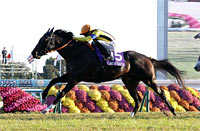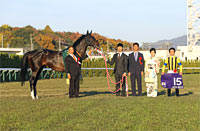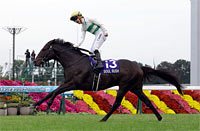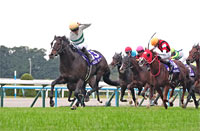Mile Championship (G1) - Data Analysis
Spring mile champion decider in which race favorites have suffered nine consecutive defeats
Of the 26 Mile Championship winners from 1984 (launch year) to 2009, 14 (over half) were backed as the race favorite. However, the nine winners from 2010 were all backed as 2nd favorite or below, including seven backed as 4th favorite or below. In other words, the Mile Championship is a tough race to call in which race favorites have struggled to win in recent years. Let’s now analyze some features shared by successful runners in this race based on results over the last 10 years.
Focus on performance by age
Looking at performances by runners over the last 10 years in terms of age, we find that runners aged “5 or below” made up 26 of the 30 Top 3 finishers, with runners aged “4” achieving a comparatively strong Top 3 ratio of 36.1%. Conversely, runners aged “6 and above” had a Top 3 ratio of only 8.0%. This suggests we should focus on younger runners aged 5 or below. [Table 1]
[Table 1] Performance by age (last 10 years)
| Age |
Performance
[1st-2nd-3rd-4th or lower] |
Win ratio |
Top 2 ratio |
Top 3 ratio |
| 3 |
2-0-2-31 |
5.7% |
5.7% |
11.4% |
| 4 |
3-6-4-23 |
8.3% |
25.0% |
36.1% |
| 5 |
3-3-3-49 |
5.2% |
10.3% |
15.5% |
| 6 |
1-1-1-30 |
3.0% |
6.1% |
9.1% |
| 7 |
0-0-0-12 |
0% |
0% |
0% |
| 8 |
1-0-0-4 |
20.0% |
20.0% |
20.0% |
| 5 or below |
8-9-9-103 |
6.2% |
13.2% |
20.2% |
| 6 or above |
2-1-1-46 |
4.0% |
6.0% |
8.0% |
In addition, the four Top 3 finishers that were aged “6 or above” all had experience of finishing in the Top 4 of the “Mile Championship of the previous year.” The Top 4 finishers of the 2018 Mile Championship were all aged 4 or below at the time (currently 5 or below), so we should generally lower our expectations of runners aged “6 or above” this year. [Table 2]
[Table 2] Among runners aged “6 or above,” performance by experience of finishing in Top 4 of “Mile Championship of previous year” (last 10 years)
| Experience |
Performance
[1st-2nd-3rd-4th or lower] |
Win ratio |
Top 2 ratio |
Top 3 ratio |
| Yes |
2-1-1-7 |
18.2% |
27.3% |
36.4% |
| No |
0-0-0-39 |
0% |
0% |
0% |
Pay careful attention to finish in previous race
Looking at performances by runners over the last 10 years in terms of finish in their previous race, we observe that runners that had finished in the “Top 3” of their previous race achieved a comparatively strong Top 3 ratio of 31.3%. Conversely, runners that had finished “10th or lower” in their previous race produced zero Top 3 finishers. [Table 3]
[Table 3] Performance by finish in previous race (last 10 years)
Finish in
previous race |
Performance
[1st-2nd-3rd-4th or lower] |
Win ratio |
Top 2 ratio |
Top 3 ratio |
| Top 3 |
6-7-8-46 |
9.0% |
19.4% |
31.3% |
| 4th-9th |
4-3-2-63 |
5.6% |
9.7% |
12.5% |
| 10th or lower |
0-0-0-40 |
0% |
0% |
0% |
In addition, if we limit our analysis to the six years from 2013, we note that runners that had finished “8th or lower” in their previous race were all beaten to 4th or lower. In other words, we should pay careful attention to the finish in the previous race. [Table 4]
[Table 4] Performance by finish in previous race (last 6 years)
Finish in
previous race |
Performance
[1st-2nd-3rd-4th or lower] |
Win ratio |
Top 2 ratio |
Top 3 ratio |
| Top 3 |
4-5-4-30 |
9.3% |
20.9% |
30.2% |
| 4th-7th |
2-1-2-26 |
6.5% |
9.7% |
16.1% |
| 8th or lower |
0-0-0-33 |
0% |
0% |
0% |
Fillies/mares have not entered the Top 3 since 2012
Of the 30 Top 3 finishers over the last 10 years, 27 were colts/horses or geldings. Meanwhile, fillies/mares have struggled somewhat with a Top 3 ratio of only 10.0%. In addition, the last filly/mare to finish in the Top 3 was Donau Blue (third place in 2012), and the last filly/mare to finish in the Top 2 was Blumenblatt (winner in 2008). If trends in recent years are anything to go by, we should lower our expectations of fillies/mares. [Table 5]
[Table 5] Performance by gender (last 10 years)
| Gender |
Performance
[1st-2nd-3rd-4th or lower] |
Win ratio |
Top 2 ratio |
Top 3 ratio |
| Colts/horses or geldings |
10-10-7-122 |
6.7% |
13.4% |
18.1% |
| Fillies/mares |
0-0-3-27 |
0% |
0% |
10.0% |
Extremely heavy runners do not inspire confidence
Among runners over the last 10 years, looking at performances for those that had contested “a domestic race” in their previous race in terms of weight in that race, we find that runners that weighed in at “520kg or above” in their previous race struggled with a Top 3 ratio of 8.0%. In addition, if we limit our analysis to the races from 2013, we note that this group delivered performance of [0-0-0-14] (Top 3 ratio of 0%), with all runners in the group beaten to 4th or lower. In other words, we should lower our expectations of extremely heavy horses. [Table 6]
[Table 6] Among runners that had contested a “domestic race” in their previous race, performance by weight in that race (last 10 years)
| Weight in previous race |
Performance
[1st-2nd-3rd-4th or lower] |
Win ratio |
Top 2 ratio |
Top 3 ratio |
| Less than 520kg |
10-8-8-123 |
6.7% |
12.1% |
17.4% |
| 520kg or above |
0-2-0-23 |
0% |
8.0% |
8.0% |
Runners that contested a small-field race last time out have also struggled in recent years
Of the 18 Top 3 finishers over the last six years, 16 had contested a race with “13 or more” runners last time out. Meanwhile, those that had contested a race with “12 or fewer” runners last time out struggled with a Top 3 ratio of 11.0%. This suggests we need to discount runners that have contested a small-field race last time out. [Table 7]
[Table 7] Performance by number of runners in previous race (last 6 years)
Number of runners in
previous race |
Performance
[1st-2nd-3rd-4th or lower] |
Win ratio |
Top 2 ratio |
Top 3 ratio |
| 12 or fewer |
0-1-1-16 |
0% |
5.6% |
11.1% |
| 13 or more |
6-5-5-73 |
6.7% |
12.4% |
18.0% |
Strong performance by runners that enjoyed success in higher grade race held in the same year
Of the 18 Top 3 finishers over the last six years, 16 had experience of finishing in the Top 5 of a “JRA G1 or G2 race held in the same year and contested by 16 or more runners.” Conversely, runners without such experience struggled with a Top 3 ratio of 3.8%. In other words, runners that have only enjoyed success in a race in 2018 or before, an allowance-class/open-class stakes/G3 race, or a small-field race are unlikely to chase the top places. [Table 8]
[Table 8] Performance by experience of finishing in Top 5 of “JRA G1 or G2 race held in the same year and contested by 16 or more runners” (last 6 years)
| Experience |
Performance
[1st-2nd-3rd-4th or lower] |
Win ratio |
Top 2 ratio |
Top 3 ratio |
| Yes |
6-5-5-39 |
10.9% |
20.0% |
29.1% |
| No |
0-1-1-50 |
0% |
1.9% |
3.8% |
Seek out the winner!
Runners that have finished in the Top 4 of a G1 race held in the same year are strong performers
The last six winners all had experience of finishing in the Top 4 of a “JRA G1 race held in the same year.” As apparent from the trend shown in Table 8, we should first check runners that have been successful in higher grade races held since the turn of the year. In addition, other features shared by the six winners were that they had finished in the Top 7 of their previous race, that they were colts/horses, that they weighed in at under 520kg in their previous race, and that they entered a race contested by 13 or more runners in their previous race. In other words, we should also focus on whether the runners clear the conditions in Table 3, Table 4, Table 5, Table 6, and Table 7. [Table 9]
[Table 9] Winners’ “highest finish in a ‘JRA G1 race held in the same year,’” “finish in previous race,” “gender,” “weight in previous race,” and “number of runners in previous race” (last 6 years)
| Year |
Winner |
Highest finish in a ‘JRA G1
race held in the same year’ |
Finish in previous race |
Gender |
Weight in previous race |
Number of runners in previous race |
| 2013 |
Tosen Ra |
2nd [Tenno Sho (Spring)] |
3rd |
Horse |
456kg |
13 |
| 2014 |
Danon Shark |
4th [Yasuda Kinen] |
7th |
Horse |
442kg |
16 |
| 2015 |
Maurice |
1st [Yasuda Kinen] |
1st |
Colt |
510kg |
17 |
| 2016 |
Mikki Isle |
2nd [Sprinters Stakes, etc.] |
2nd |
Horse |
486kg |
16 |
| 2017 |
Persian Knight |
2nd [Satsuki Sho
(Japanese 2000 Guineas)] |
5th |
Colt |
476kg |
15 |
| 2018 |
Stelvio |
4th [Satsuki Sho
(Japanese 2000 Guineas)] |
2nd |
Colt |
468kg |
13 |
(Masaya Ibuki)
|



















